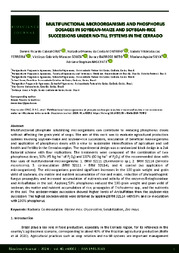Multifunctional microorganisms and phosphorus dosages in soybean-maize and soybean-rice successions under no-till systems in the cerrado.
Multifunctional microorganisms and phosphorus dosages in soybean-maize and soybean-rice successions under no-till systems in the cerrado.
Autoria: CRUZ, D. R. C.; MONTEIRO, N. O. da C.; FERREIRA, I. V. L.; SOUZA, V. G. M.; BARROSO NETO, J.; SILVA, M. A.; NASCENTE, A. S.
Resumo: Multifunctional phosphate solubilizing microorganisms can contribute to reducing phosphorus doses without affecting the grain yield of crops. The aim of this work was to evaluate agricultural production systems involving soybean-maize and soybean-rice successions, inoculation of beneficial microorganisms and application of phosphorus doses with a view to sustainable intensification of agriculture and soil health and fertility in the Cerrados region. The experimental design was a randomized block design in a 2x4 factorial scheme with four replications. The treatments were composed of the combination of two phosphorus doses, 50% (45 kg ha-1 of P2O5) and 100% (90 kg ha-1 of P2O5) of the recommended dose with four uses of multifunctional microorganisms: 1. BRM 32111 (Burkholderia sp.), 2. BRM 32114 (Serratia marcescens), 3. co-inoculation (BRM 32111 + BRM 32114), and 4. control (no application of microorganisms). The microorganisms provided significant increases in the 100-grain weight and grain yield of soybeans, dry matter and nutrient accumulation of rice and maize, reduction of phytopathogenic fungus propagules, and increased accumulation of nutrients and activity of the enzymes Betaglicosidase and Arilsulfatase in the soil. Applying 50% phosphorus reduced the 100-grain weight and grain yield of soybean, dry matter and nutrient accumulation of rice, propagules of Trichoderma spp., and the nutrients in the soil. The soybean-maize succession showed higher levels of Arylsulfatase than the soybean-rice succession. The highest soybean yields were obtained by applying BRM 32114 with 50% and co-inoculation with 100% phosphorus.
Ano de publicação: 2024
Tipo de publicação: Artigo de periódico
Unidade: Embrapa Arroz e Feijão
Palavras-chave: Arroz, Bactéria, Cerrado, Co-inoculation, Glycine Max, Microorganisms, Microrganismo, Milho, Oryza Sativa, Plantio Direto, Soja, Zea Mays
Observações
1 - Por padrão são exibidas publicações dos últimos 20 anos. Para encontrar publicações mais antigas, configure o filtro ano de publicação, colocando o ano a partir do qual você deseja encontrar publicações. O filtro está na coluna da esquerda na busca acima.
2 - Para ler algumas publicações da Embrapa (apenas as que estão em formato ePub), é necessário ter, no celular ou computador, um desses softwares gratuitos. Sistemas Android: Google Play Livros; IOS: iBooks; Windows e Linux: software Calibre.
Acesse outras publicações
Acesse a Base de Dados da Pesquisa Agropecuária (BDPA) para consultar o acervo completo das bibliotecas da Embrapa.

